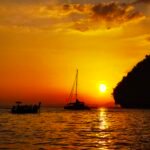Introduction to Jiuzhaigou
Jiuzhaigou, located in the northwest of Sichuan Province within the Aba Tibetan and Qiang Autonomous Prefecture, is situated in Zhangzha Town, Jiuzhaigou County. The area gets its name from the nine Tibetan villages found within the valley, including Shuzheng, Heyez, and Zechawa. Here, you can find ancient Tibetan villages, stone grinding houses, boardwalks, and prayer flags. The landscape is dominated by towering snow-capped mountains, spectacular waterfalls, crystal-clear lakes, enchanting travertine flows, and lush green forests. It’s often referred to as a “paradise on earth” or a “fairytale world.”
Personal Impression:
Autumn in Jiuzhaigou is breathtaking. The pristine forests exude a serene chill, and under the brilliant sunlight, the lakes shimmer like exquisite gemstones. The dancing shadows of the trees and the gentle breeze create a magical atmosphere, while the clouds shroud Longhai in a mystical haze, resembling a fairytale realm. With such stunning beauty all around, it’s hard to take it all in. I truly wish I could be like Nezha, with three heads and six arms, and many more pairs of eyes to appreciate all that Jiuzhaigou has to offer.
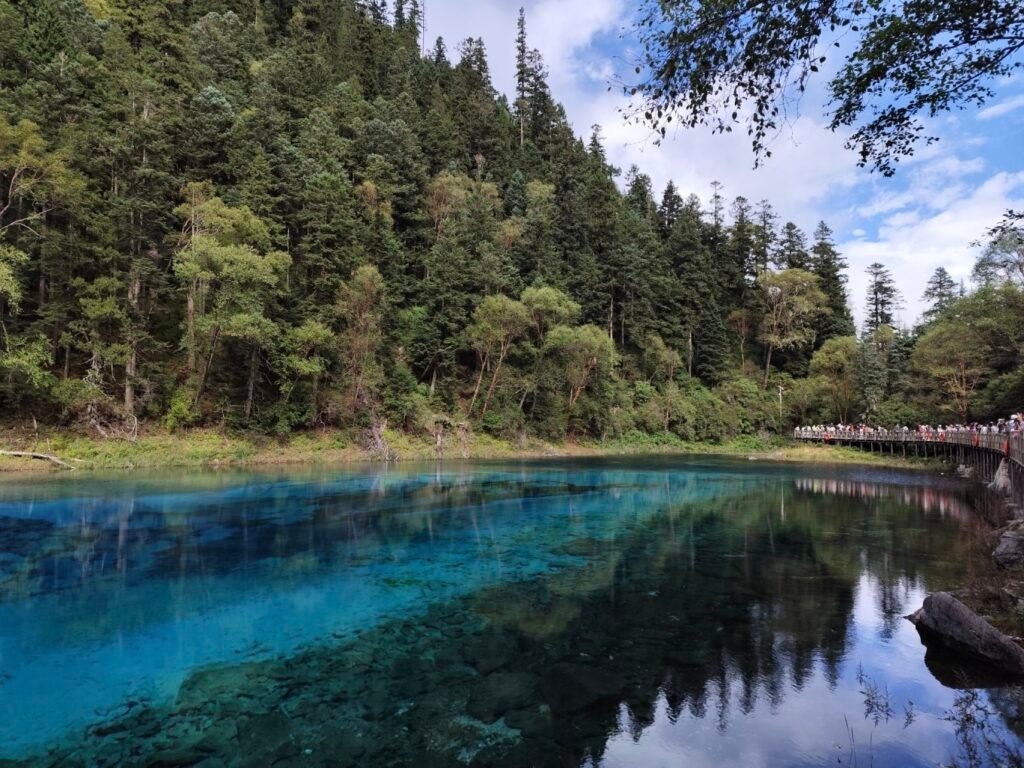
Jiuzhaigou is located in Zhangzha Town, Jiuzhaigou County, within the Aba Tibetan and Qiang Autonomous Prefecture in Sichuan. The scenic area consists of three valleys where all the attractions are situated. Winters here are not harsh, and summers are cool, with each season offering a unique view. It is renowned for its “Six Wonders”: emerald lakes, cascading waterfalls, colorful forests, snow-capped peaks, Tibetan culture, and blue ice.
Some of the famous attractions include Shuzheng Sea, Nuorilang Waterfall, Wuhua Lake, Rhinoceros Lake, Five-Color Pool, and Pearl Beach. No matter when you visit throughout the year, you’ll feel as if you’ve stepped into a fairyland.
Note: In Jiuzhaigou, be wary of scammers selling fake herbal medicine. These fraudsters often pose as traditional Chinese medicine practitioners or herbal merchants and may approach unsuspecting tourists as they browse herbal stalls. You might encounter them both within the scenic area and on buses traveling to the site. Stay alert to avoid being deceived!
Shuzheng Sea
This is the representative landscape of Shuzheng Valley. Shuzheng Sea stretches for several miles, with a height difference of nearly 100 meters, formed by 19 lakes of varying sizes arranged like terraced fields. Between these lakes, you’ll find a lush growth of willows, poplars, pines, firs, and a variety of shrubs. The water cascades from the upper lakes, flowing through the thickets and creating wide, beautiful waterfalls, showcasing the remarkable phenomenon of “trees growing in water and water flowing in the forest.”
The best angle for photographing Shuzheng Sea is from the roadside opposite Shuzheng Village.
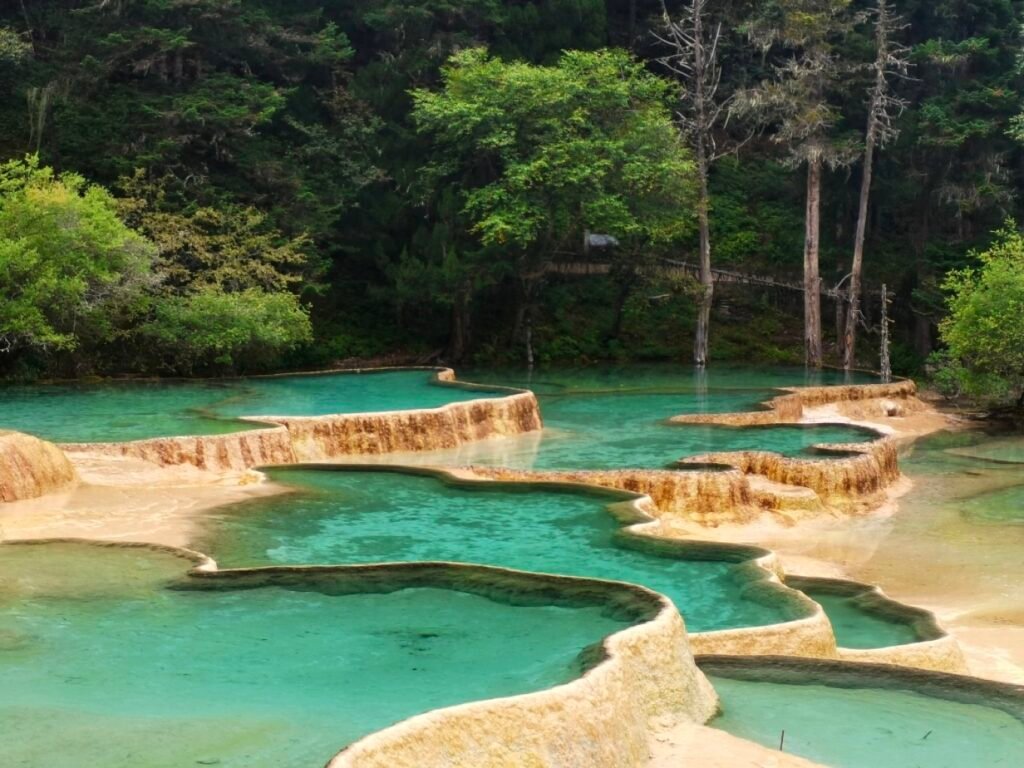
Nuorilang Waterfall
The name “Nuorilang” is a transliteration from Tibetan, meaning “male deity,” symbolizing grandeur and majesty. The waterfall has a drop of 20 meters and a width of 300 meters, with a flat top resembling a terrace. There’s an observation platform built across from the waterfall, where visitors can enjoy a panoramic view. In the morning, when the sunlight shines, colorful rainbows often arc across the valley, enhancing the waterfall’s captivating beauty. The cascading water flows like a curtain, creating countless splashes that resemble scattered beads.
In winter, the waterfall frequently forms a massive ice curtain, with numerous ice columns hanging from the cliffs, transforming the area into a rare world of ice crystals. Nuorilang Waterfall is the widest travertine waterfall discovered in China to date.

Xiuniuhai (Rhinoceros Lake)
Located at an altitude of 2,315 meters, Xiuniuhai is an expansive body of water and the second largest lake in Jiuzhaigou, following Changhai. It is one of the most picturesque lakes in the area, renowned for its stunning reflections. At the northern end, you’ll find a cluster of reeds where you can gaze upon the majestic Mount Colorful Goddess, while the southern shore features a mix of woodlands and a silver waterfall. In between lies a vast, intoxicatingly blue lake. The ethereal clouds and the reflections of red leaves and green trees dance upon the azure surface, creating a dreamlike scene that is simply breathtaking.
Boat rentals are available on the lake, making it the only spot for water activities in Jiuzhaigou. According to legend, a Tibetan lama suffering from a serious illness once rode his rhinoceros through this area. After drinking from the lake, he miraculously recovered. The old lama became so attached to the lake that he drank its water day and night, ultimately riding his rhinoceros into the lake to settle permanently, which is why this body of water is called Xiuniuhai.
If you enter the boardwalk, the dense trees around Xiuniuhai will obstruct your view for reflection photography. It’s recommended to hike along the road from Ping’an Bridge for the best shots. The ideal time for photography is from 7:30 to 9:00 AM when the waters are calm.

Huohua Hai (Fire Flower Lake)
Huohua Hai is located between Shuanglong Hai and Wolong Hai. You can reach the viewing platform by crossing the boardwalk that spans the waterfall of Huohua Hai. The lake’s surface is a deep blue, surrounded by dense forests. Each morning at dawn, the lake shimmers with golden light, resembling countless sparks dancing upon the water, creating a stunning visual spectacle. In the evening, viewing Huohua Hai against the light is also recommended, as you will see the shimmering reflections.
There is a 51-step stone staircase alongside the mountain road that leads directly to Huohua Hai. As visitors descend the steps, they can enjoy views of the Huohua Hai waterfall. The waterfall is over 50 meters wide and 8 meters high, consisting of two streams that are forever separated, earning it the name “Xiangsi Falls” (Lovesick Falls).
The best time to photograph Huohua Hai is in the morning, around 8:00 AM when the sun emerges. As the morning light gradually illuminates the forest, the mountains in the background fade into darkness. At this moment, it’s advisable to measure exposure based on the sunlit areas, allowing the background mountains to darken. The contrast between the sparkling water and the dark mountains adds to the mystery and allure of the scene. Additionally, water birds are most active during this time (a lens of 300mm or longer is needed to capture them).
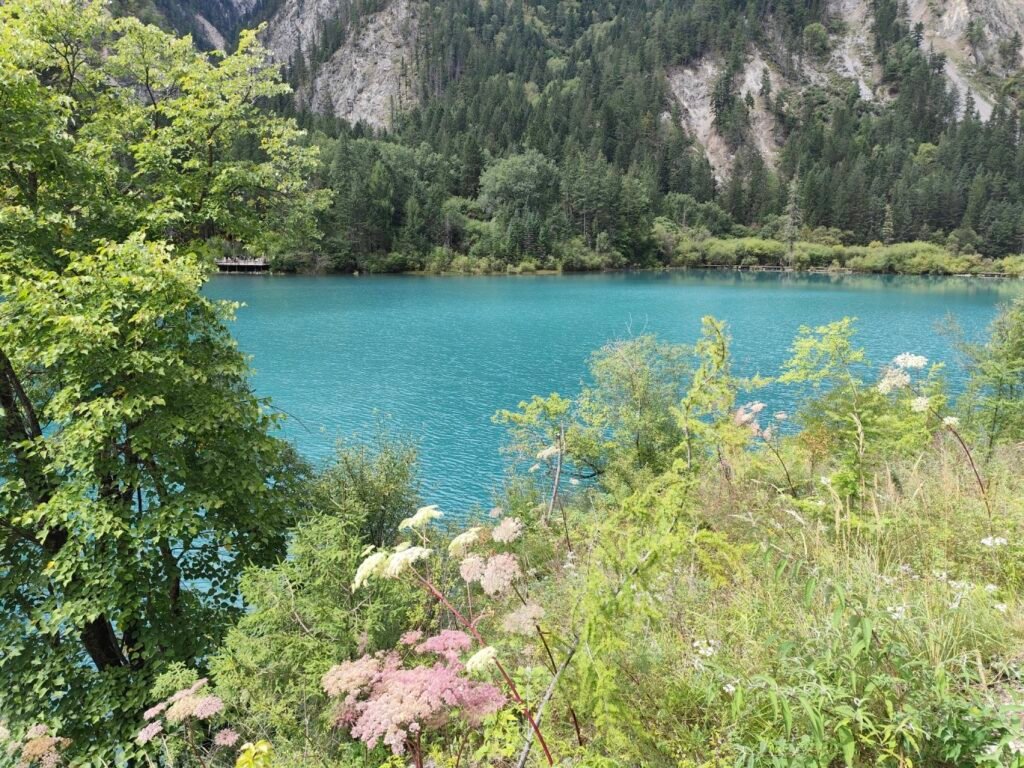
Wuhua Hai (Five Flower Lake)
Wuhua Hai is located at the end of the upper reaches of the Quehua River in the Rize Valley. The vibrant colors of the lake are a result of the calcium deposits at the bottom, along with the presence of colorful algae and submerged plants, which create a stunning mosaic of colors. In the same body of water, hues of light red, pale yellow, deep green, dark blue, and royal blue emerge, resembling countless gemstones embedded in a grand piece of jewelry, exuding a luxurious and radiant charm. Wuhua Hai is hailed as a “unique wonder of Jiuzhaigou.”
In the golden autumn season, the vibrant colors of the surrounding trees reflect on the lake’s surface, blending with the colors beneath to create a dazzling kaleidoscope of hues that even surpasses the imagination of any painter.
To access Rize Valley, visitors must pass through Laohuzui (Tiger Mouth), which is a winding uphill road where drivers typically don’t stop. Guests can disembark at Wuhua Hai and walk up, or explore Xiongmao Hai (Panda Lake) and stroll down along the road.



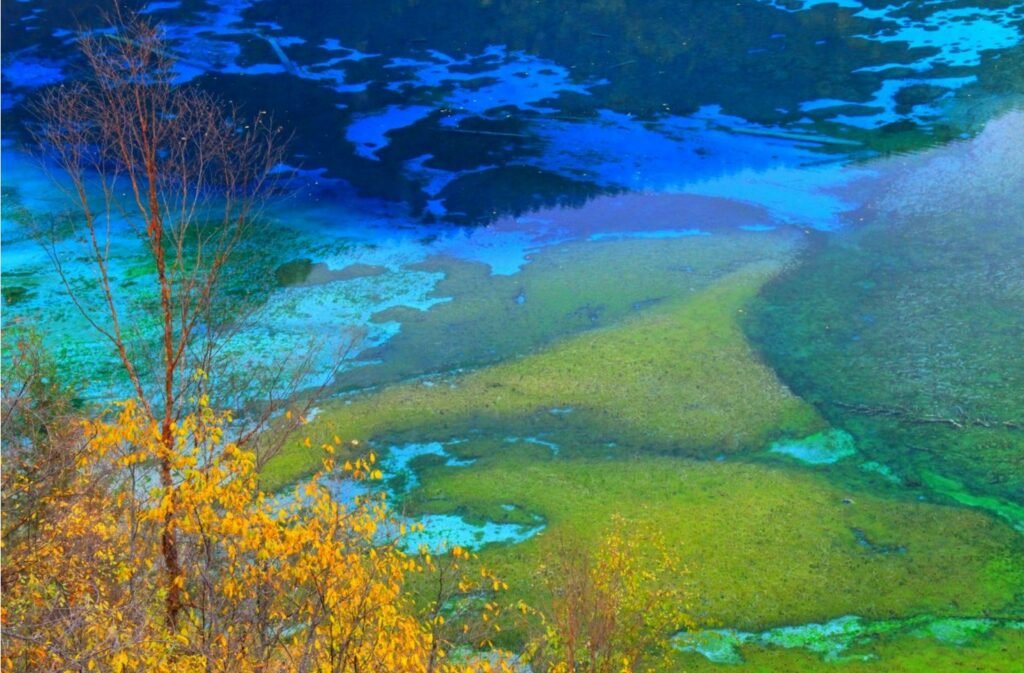
Jianzhuhai (Arrow Bamboo Lake)
Jianzhuhai is surrounded by a large number of arrow bamboos, which are a favored food of giant pandas. Its proximity to Pandahai (Panda Lake) also contributes to its name. The lake is expansive and stretches long, with a beautiful blue hue, famous for its reflections. On windless days, visitors can marvel at the breathtaking scenery where it’s hard to tell if the mountains are plunging into the water or if the water is enveloping the mountains.
In winter, while many lakes in Jiuzhaigou are covered with thick ice, Jianzhuhai remains a pool of clear blue water. The lake features numerous calcified dead trees that form unique coral-like structures, while some new trees grow on the decayed wood, a phenomenon known as “rotten wood renewal,” or more poetically, “the dead wood meets spring” and “rebirth trees.” The water from Jianzhuhai flows into the forest, splitting into several streams due to debris from collapses, creating the Jianzhuhai Waterfall. This waterfall has a large span with a gentle drop, forming a graceful arc. Here, the interplay of the blue lake, the white waterfall, and the dancing flower petals creates a harmonious scene of motion and stillness, a striking contrast of blue and white.
After disembarking at Jianzhuhai, make sure to walk 200 meters in the opposite direction to reach the foot of the mountain along the boardwalk. This route allows you to avoid crowds and enjoy the stunning views in solitude.
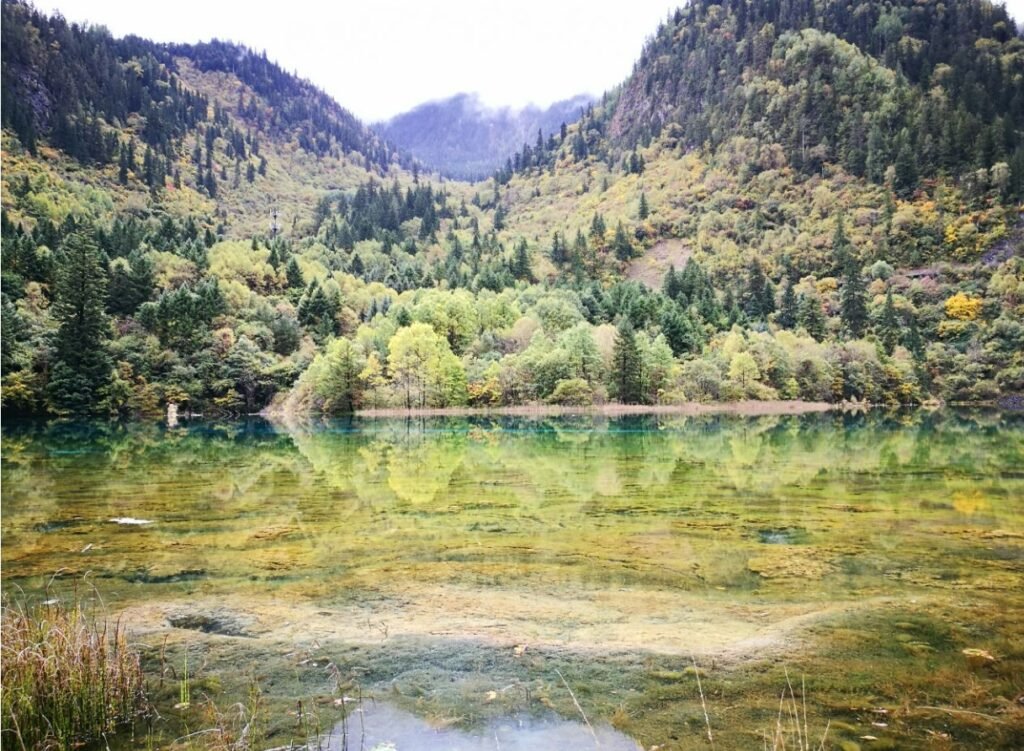
Huanglong Scenic Area
Huanglong Scenic Area is located at the foot of Xuebaoding, the main peak of the Minshan Mountains. It features a ridge of travertine that rises gradually from south to north, resembling a gigantic dragon that seems to leap upward, resting in the crystalline embrace of the snow-capped glaciers. Huanglong Valley stretches approximately 7.5 kilometers in length and about 1.5 kilometers in width.
As visitors ascend the stone steps from the valley entrance, they encounter the undulating spine of the dragon, adorned with numerous streams and waterfalls that tumble down, resembling the dragon playfully splashing in the water. The mountains are adorned with vibrant rhododendrons, fiery red maple leaves, and shimmering golden moss, all harmonizing with the colorful pools of varying sizes, creating a breathtaking landscape.
Key attractions in Huanglong include:
- Yingbin Pool (Welcome Pool)
- Feipu Liuhui (Waterfall Flow)
- Xishen Cave (Washing Cave)
- Jinsapu Di (Golden Sand Ground)
- Bonzai Pool
- Mingjing Reflection Pool
- Zhengyan Pool (Competing Flowers Pool)
- Huanglong Cave
- Wucai Pool (Five-Color Pool)
- Zhuanhua Pool (Turning Flower Pool)
- Huanglong Ancient Temple


Miya Luo Scenic Area
“Miya Luo” is a Tibetan term meaning “fun valley.” The scenic area is located in the middle of the tourism route from Chengdu to Jiuzhaigou and Huanglong, situated in the valley of the Zha Gu Na River, a tributary of the Min River. This region features a continuous chain of mountains, intertwined rivers, and vast seas of forests. It is especially famous for its stunning autumn foliage.
Every autumn (September and October), the maples, birches, goosefoot pines, and larches along the riverbanks gradually change color as frost touches their leaves, transforming them into brilliant shades of red and gold. At this time, the mountains are ablaze with color, and the vibrant red leaves adorn the landscape, creating a remarkable sight across thousands of miles.
In addition to the red leaf viewing areas, the main attractions within the scenic area include Bipeng Valley, Taoping Qiang Village, Gurgou Hot Springs, Jiang Wei City, and the Black Tiger Qiang Village, each with its unique characteristics.
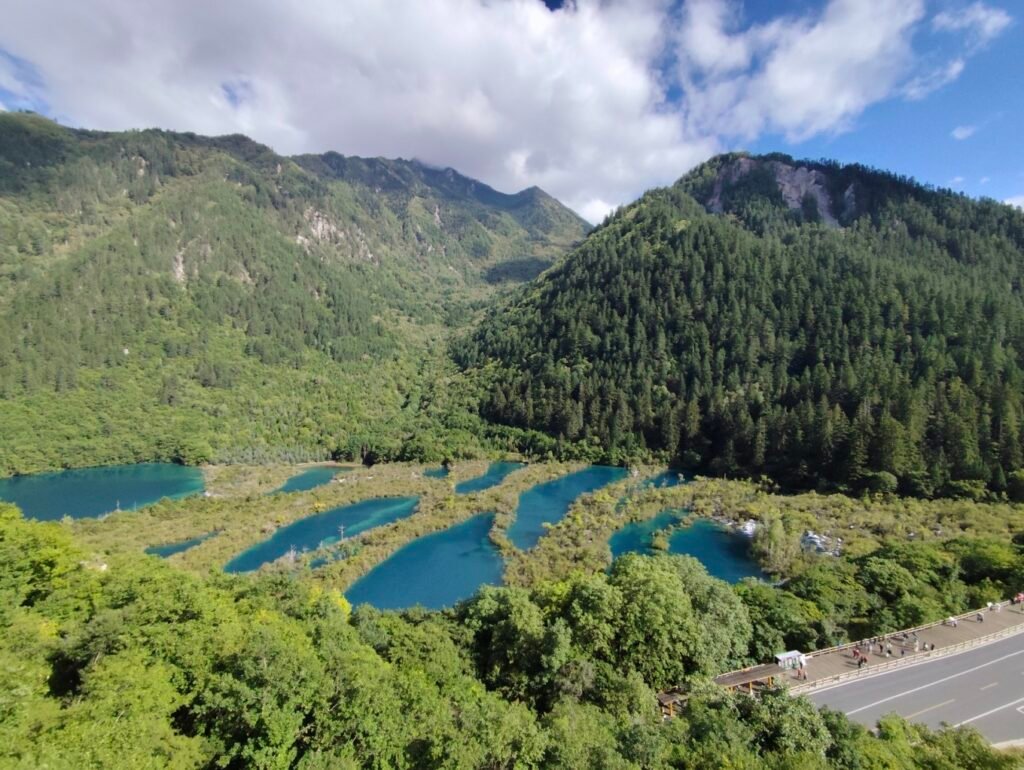

Accommodation Introduction:
In Jiuzhaigou, accommodations are primarily concentrated in three villages: He Ye Zhai, Shu Zheng Zhai, and Ze Cha Wa Zhai, all located outside the scenic area. These places offer good lodging conditions, with a variety of choices and convenient dining and shopping options, as well as entertainment such as Tibetan song and dance performances. However, they are a bit far from the entrance of the valley, requiring a taxi (around 10-15 yuan) or a 30-minute walk.
Near the entrance of the valley, there are more upscale hotels, such as Sheraton International Hotel, Xingyu International Hotel, Jiugong Hotel, Gesang Hotel, He Ye Ying Bin Hotel, and Jiutong Hotel, with prices ranging from 200 yuan to over 1,000 yuan. Additionally, hostels are also a great choice, such as Caogen Renjia and Langjie Zhijia, with bed prices ranging from 50 to 150 yuan.
Food Introduction:
Jiuzhaigou not only boasts enchanting landscapes but also delightful local cuisine. The Tibetan and Qiang people are known for their warm and passionate nature, which is vividly reflected in their culinary culture. The local specialties primarily feature beef and lamb, but the cooking methods vary slightly between the Tibetan and Qiang cuisines: Tibetans focus on smoked meats, complemented by barley wine, butter tea, and yogurt; while the Qiang people prefer sour and spicy meat dishes and animal organs. Additionally, the local Han population primarily enjoys Sichuan cuisine.
Due to many supplies being transported from outside the region, food prices can be quite high. It’s advisable for visitors not to overly worry about dining options, as local hotels offer delicacies like potato cakes, Jiuzhai persimmons, buckwheat pancakes, and Jiuzhai pickled vegetables.
Ethnic specialty dishes include roasted whole lamb, hand-pulled beef steak, mixed noodles, potato dumplings, and barley wine. Each accommodation site offers local ethnic cuisine, though prices can be steep. Most dishes are inspired by Tibetan flavors, so it’s best to choose carefully.






Recommended Travel Itinerary:
For a comprehensive visit to Jiuzhaigou, a two-day exploration is generally required. However, due to ticketing considerations, most visitors only spend one day there. In addition to Jiuzhaigou, nearby attractions like Huanglong, Miyao, Bipenggou, Wenchuan, Qingcheng Mountain, and Dujiangyan are also popular among tourists, leading to a variety of travel routes. Here are a few representative options:
Classic One-Day Jiuzhaigou Tour
Itinerary Design:
- Rize Valley (Mirror Lake – Pearl Beach – Five Flower Lake – Panda Lake – Arrow Bamboo Lake)
- Nuorilang Center
- Zecha Valley (Five Flower Lake – Long Lake)
- Nuorilang Center
- Shuozheng Valley (Rhino Lake – Tiger Lake – Tree Spirit Group Lake – Reed Sea – Bonsai Beach)
Itinerary Details: Upon entering the scenic area, take the sightseeing bus to Mirror Lake in Rize Valley, as it is most beautiful at 8 AM—calm and still, resembling a smooth, unblemished mirror, making it the best time for photos. From there, continue exploring Pearl Beach, Five Flower Lake, Panda Lake, and Arrow Bamboo Lake, eventually reaching the original forest.
Given that the beauty of Jiuzhaigou primarily lies in its water features, and since time is limited in one day, it’s recommended to skip the original forest and head back to Nuorilang Center. Enjoy lunch at Nuorilang Center, where boxed meals, instant noodles, and buffet options are available.
After lunch, board the sightseeing bus to Zecha Valley to visit the Colorful Pool and Long Lake. Generally, 1.5 hours is sufficient for these two spots.
Next, return to Nuorilang Center, likely around 2 PM, and then walk to Shuozheng Valley. Follow the trail from Nuorilang Waterfall along Shuozheng Valley to explore Rhino Lake, Tiger Lake, Tree Spirit Group Lake, Reed Sea, and finally, Bonsai Beach. At Bonsai Beach, board the bus to return to the park entrance, concluding your day’s journey.
Best Travel Time:
The stunning scenery of Jiuzhaigou varies with the seasons, but autumn, particularly from October 15 to 30, is the most beautiful. During this period, most leaves have fully changed color, showcasing brilliant yellows and vibrant reds, complemented by other colors that create a picturesque transition. Jiuzhaigou transforms into a divine palette, making it an incredible sight.
In addition, every winter (January and February), Jiuzhaigou becomes a winter wonderland covered in ice and snow.
Clothing Index:
Jiuzhaigou has a very suitable climate. The average temperature in summer is around 20°C, while in autumn (October), it averages between 10-15°C. Therefore, when visiting in summer, pack not only short sleeves but also a long-sleeve shirt or jacket. For autumn, a fleece layer paired with a windbreaker should be sufficient, although a waterproof jacket is preferable. In winter, thicker down jackets are necessary to stay warm.

